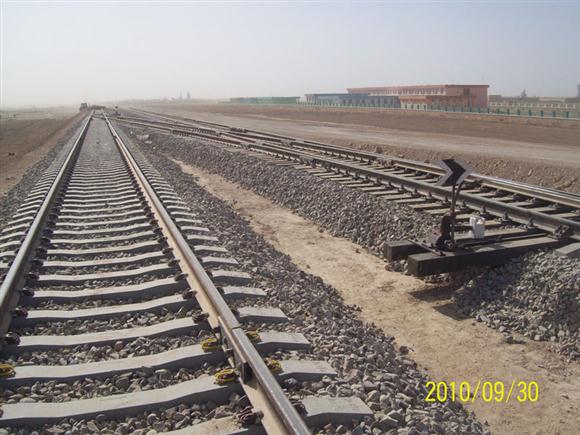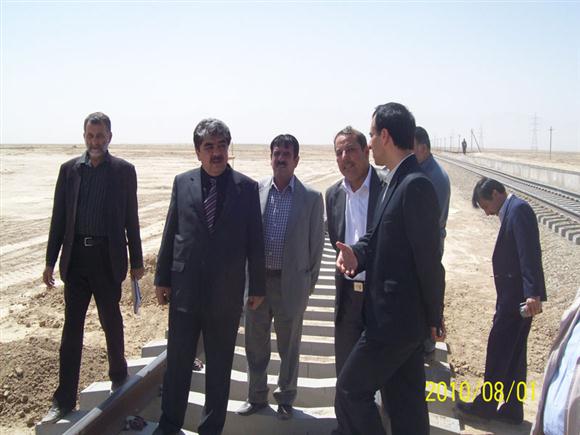“This was the first steam train of the Kabul Railroad – we got chased away from taking pictures”. Photo taken by Timothy Bates, 12 November 2010
photos
Minister of Public Works visits railway project
A photo from the Ministry of Public Works website showing an official visit to the Hayratan to Mazar-i-Sharif railway project, dated 1 August 2010, plus a view of some track dated 30 September 2010.
“The visit of minister of public works to the project of railways Heyratan-Mazar sharif”

View from the museum
The view from the Archaeology Museum. In the foreground are early trains, a form of transportation first brought to Afghanistan by the British. Unfortunately there is no train service in Afghanistan today.
Flickr photo taken on 14 January 2009 by Lauras Eye (CC BY-ND 2.0). The locos were supplied from Germany.
Outside the Kabul Museum
Opening of the Friendship Bridge, 1982
The RIA Novosti news agency has various photos online, including these showing officials at the formal opening of the Friendship Bridge between the USSR and Afghanistan on 11 May 1982, and Soviet military use of the bridge.
- Photo #481959:
Secretary General of the Central Committee of the People’s Democratic Party of Afghanistan, Chairman of the Revolutionary Council of the Democratic Republic of Afghanistan Babrak Karmal and First Secretary of the Central Committee of the Communist Party of Uzbek Soviet Socialist Republic Sharaf Rashidov at the opening ceremony of the highway and railroad bridge between the USSR and Afghanistan.
V. Chistiakov, 11.05.1982 - Photo #481950:
Babrak Karmal, general secretary of the People’s Democratic Party of Afghanistan and chairman of the Revolutionary Council of the Democratic Republic of Afghanistan, at the ceremony opening a motor and railroad bridge between the Soviet Union and Afghanistan.
V. Chistiakov, 11.05.1982 - Photo #481951:
Automobile and rail bridge across Amu Darya River between USSR and Afghanistan. The bridge is 816 meters long.
V. Chistiakov, 11.05.1982
A Soviet freight train at Hayratan, with freight being unloaded from railway vans into custom-painted lorries:
- Photo #660247:
Unloading humanitarian aid from Soviet Union. Hairaton port. Democratic Republic of Afghanistan.
V. Zupharov, 01.08.1986.
And the road at the time:
- Photo #636884:
The road from Hairaton to Kabul.
V. Kiselev, 01.10.1989
The Soviet withdrawal:
- Photo #476670:
The first military convoy crosses the Friendship Bridge over the Amu Darya River during the Soviet troop pullout from Afghanistan.
V. Kiselev, 18.05.1988 - Photo #482919:
The last Soviet combat vehicle leaves Afghanistan. The USSR conducted a full pullout of its limited troop contingent from Afghanistan in compliance with the Geneva accords.
A. Solomonov, 15.02.1989 - Photo #482941:
Back to homeland. A welcome ceremony for Soviet troops returning from Afghanistan near Termez, Uzbek Soviet Socialist Republic
Alexander Liskin, 06.02.1989 - Photo #644825:
Soviet troop withdrawal from Afghanistan. Soviet troop column returns to homeland.
V. Kiselev, 01.02.1989
On a railway-related subject:
- Photo #483133:
On November 1986 Moscow customs officers found 1217 of hashish in a railway container which was bound from Afghanistan to FRG. The owner of contraband goods is American company Specific International. The drug was destroyed at the training ground of the Fire Inspection Administration of the Moscow region in the presence of Soviet and foreign journalists.
Yuryi Abramochkin, 13.10.1987
Darulaman railway in 1926
This narrow gauge railroad ran from the Shah-do-Shamshira to Darulaman
; a photograph taken in 1926 at the Williams Afghan Media Project website. It is the same photo as the one from German magazine Uhu in February 1930, although Uhu cropped the edges.
Photos of Hayratan and its railway facilities
A good set of photos in, around and above Hayratan, taken by “Robert” in July 2010 during his Afghanistan Deployment. I have selected some of the railway shots, but the whole album is worth a look.
Here’s a shot of the new railroad. I was excited to see this train hauling track parts south Cargo being moved by rail in Afghanistan! A big first for this country. The Friendship bridge which crosses the Amu Darya into Uzbekistan. It’s used for both rail and road traffic (although not at the same time). The Hairatan border crossing is a major fuel transfer point for Afghanistan. one of the cargo yards A train that has just rolled in to Afghanistan. So nice to see commercial trade taking place in this country. Rail car being unloaded at the Hairatan crossing. Another shot of the railroad. The Afghans have made tremendous progress on it. (photo of a yellow machine)
Steam loco at the National Museum of Afghanistan
The Museum And The Palace
at the From UBC to Kabul blog by Brian Platt has some photographs of the Kabul museum and its plinthed Henschel steam locomotive which were taken on 30 October 2010. One of the locos with a collapsed cab is also visible in one of the shots.
After wondering around inside for a while, I explored the outside yard of the museum. The most interesting piece was this, the rusted-out body of a steam engine. It’s from the 1920s when Amanullah, the leader of Afghanistan from 1919 to 1929, worked his ass off to modernize the country.
…
However, Amanullah’s policies were attacked viciously by various conservative factions in Afghanistan, and eventually he was forced into exile in Europe. All that’s left of his grand train visions are sitting on the lawn of the National Museum.
Source: From UBC to Kabul, 2010-11-03
Photos of derelict Khyber Pass railway
Photos of Peshawar and the Khyber Pass taken by Anthony Maw on 27 August 2007, showing the remains of the Khyber railway.
Khojak Tunnel construction photos
These rare albumen photographs by Fred Bremner show Sindh and Baluchistan province in 1889. They are among the earliest known photographs of the area.
Includes photos of the construction of the Khojak tunnel, and a view of one of the rope inclines.


